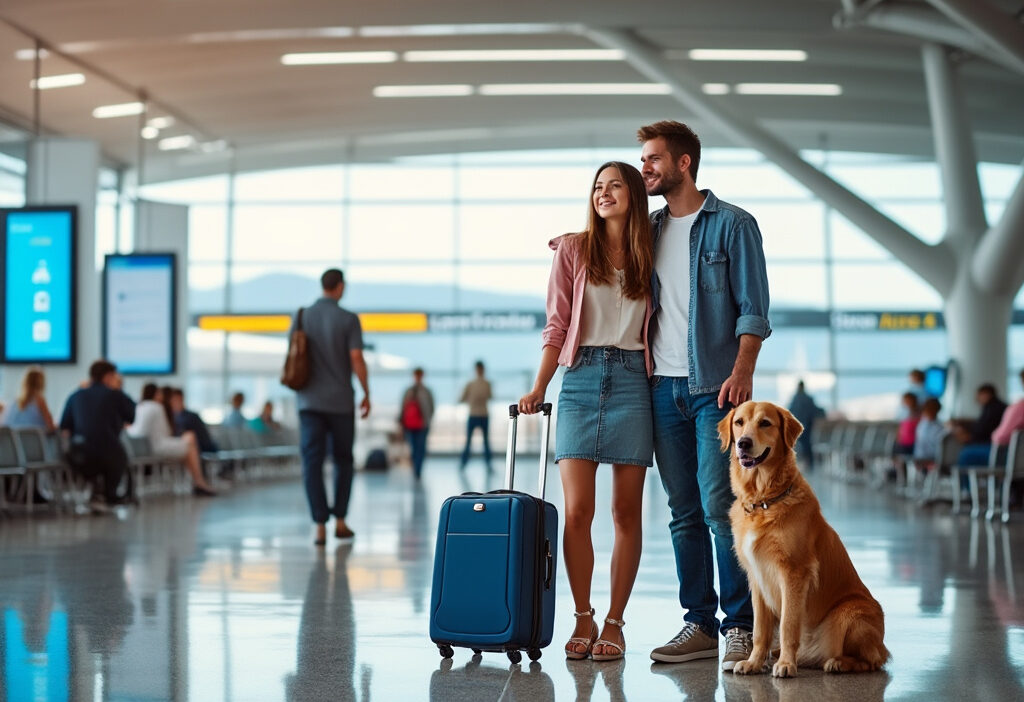Pawsport Ready – The 2025 Wave of Pet-Friendly Travel
In 2025, the pet-friendly travel sector, now famously known as “Pawsport Ready,” has seen an unprecedented surge. This burgeoning trend is chiefly driven by the evolving dynamics of pet ownership, coupled with innovative travel services that cater to the needs of pets and their human companions, signifying a cultural shift towards inclusive travel experiences.
Uncovering the Trend
The rise of Pawsport Ready travel in 2025 isn’t just a fleeting trend—it’s a cultural shift rooted in deeper societal transformations. Today, pets are no longer seen as mere companions but as integral family members, a sentiment that has reshaped the travel industry. The emotional bond between humans and their pets has intensified, driven by factors like remote work, urbanization, and evolving lifestyles. As people spend more time with their pets, the idea of leaving them behind during travel feels increasingly unthinkable.
Technological advancements have played a pivotal role in making pet-friendly travel seamless. From AI-powered pet-sitting apps to real-time health monitoring wearables, innovation has removed many barriers that once made traveling with pets cumbersome. Airlines and hotels now integrate pet-centric amenities, such as in-cabin pet suites and on-demand veterinary services, ensuring that furry travelers receive the same level of care as their human counterparts.
Societal attitudes have also shifted dramatically. Millennials and Gen Z, who prioritize experiences over possessions, view pets as essential companions in their adventures. This generational mindset has pressured businesses to adapt, making pet-friendly policies a competitive differentiator. Additionally, the rise of digital nomadism has blurred the lines between home and travel, further normalizing the presence of pets in transit.
The Pawsport Ready movement isn’t just about convenience—it’s a reflection of how deeply pets are woven into modern life. As the next chapter will reveal through hard data, this trend isn’t slowing down. The numbers will show just how much the travel industry has pivoted to accommodate this new reality, proving that pet-friendly travel is here to stay.
Statistical Landscape
The surge in pet-friendly travel is no longer anecdotal—it’s backed by compelling data. Recent studies reveal that 65% of pet owners now consider their pets when planning trips, a staggering leap from just 37% in 2020. This shift isn’t isolated; it mirrors broader societal trends where pets are increasingly seen as family members. The American Pet Products Association (APPA) reports that 85% of millennials prioritize pet-friendly accommodations, outpacing older generations and solidifying the demand for inclusive travel options.
Air travel statistics further underscore this movement. Airlines witnessed a 40% increase in pet passengers from 2022 to 2024, with carriers like Delta and United expanding their pet policies to accommodate larger breeds and emotional support animals. Hotels haven’t lagged behind—major chains like Marriott and Hilton now offer pet-centric amenities, from gourmet room-service menus to on-site dog spas, catering to a market projected to hit $20 billion by 2026.
Geographically, Europe leads in pet-friendly infrastructure, with 72% of hotels and rentals welcoming pets, compared to 58% in North America. However, Asia is catching up fast, with Japan and South Korea reporting a 30% annual growth in pet travel services. These numbers reflect a global recalibration of travel norms, where pet inclusion is no longer a niche luxury but a baseline expectation. The data paints a clear picture: the Pawsport Ready era is here, and it’s reshaping the industry one statistic at a time.
The Pet Travel Market Boom
The pet travel market is experiencing an unprecedented boom, driven by a combination of societal shifts and evolving consumer behaviors. One of the key factors fueling this growth is the rising pet adoption rate, particularly post-pandemic, as more people seek companionship. With pets increasingly viewed as family members, owners are no longer willing to leave them behind when traveling. This shift has created a surge in demand for pet-inclusive travel services, from airlines offering pet cabins to hotels providing gourmet pet menus.
Another major driver is the anthropomorphism of pets, where animals are attributed human-like needs and desires. Pet owners now expect travel experiences tailored to their furry companions, mirroring the amenities they themselves enjoy. This has led to innovations like pet spas, in-room pet-sitting services, and even pet-friendly city guides. Companies are capitalizing on this trend by integrating pet-centric features into their offerings, ensuring that every aspect of the journey—from transportation to lodging—caters to both owner and pet.
Technological advancements are also playing a pivotal role. Apps that locate pet-friendly rest stops, AI-powered pet health monitors for travel, and blockchain-based pet passports are just a few examples of how tech is streamlining pet travel. These innovations are not just conveniences but necessities in a market where expectations are higher than ever.
As the lines between human and pet travel blur, the industry is responding with creative solutions that reflect this new reality. The next chapter will delve into how accommodations are evolving to meet these demands, but it’s clear that the pet travel market’s growth is rooted in deeper cultural and technological transformations.
Redefining Accommodations
The hospitality industry is undergoing a quiet revolution, reshaping its offerings to cater to the booming demand for pet-friendly travel. No longer confined to a simple “pets allowed” policy, accommodations are now designing experiences that prioritize the comfort and enjoyment of both pets and their owners. Luxury hotels are rolling out plush pet beds, gourmet room-service menus for dogs, and even in-room spa treatments, blurring the lines between human and pet indulgence. Boutique stays are integrating dog parks, agility courses, and pet concierge services, ensuring furry guests are as pampered as their humans.
Technology plays a pivotal role in this transformation. Smart pet doors, AI-powered pet-sitting bots, and app-controlled feeding stations are becoming standard in high-end pet-friendly suites. Meanwhile, blockchain-powered pet profiles—storing vaccination records, dietary preferences, and behavioral notes—allow seamless check-ins across global hotel chains. The rise of Pawsport-verified accommodations ensures travelers can easily identify establishments that meet stringent pet-safety and comfort standards.
Beyond hotels, alternative lodging is also evolving. Vacation rentals now feature fenced yards, pet-washing stations, and curated guides to nearby dog-friendly trails and cafes. Some resorts offer “paw-ternity leave” packages, where pets and owners bond through structured activities like paddleboarding or guided nature walks. The shift reflects a deeper cultural change: pets are no longer just companions but integral members of the travel experience.
This wave of innovation isn’t just about amenities—it’s a redefinition of hospitality itself. As the industry embraces pet inclusivity, it sets the stage for the next frontier: celebrating life’s milestones with pets, from birthdays to adoptiversaries, in destinations that cater to every wagging tail.
Celebrating with Pets
As pet-friendly travel evolves beyond just accommodations, a new trend is taking center stage: celebrating milestones with pets. In 2025, pet parents aren’t just bringing their furry companions along for the ride—they’re crafting unforgettable experiences to mark special moments. Birthdays, adoption anniversaries, and even pet “paw-tirements” are now celebrated with the same enthusiasm as human milestones, driving demand for tailored events and services.
The hospitality and tourism industries have responded with bespoke pet celebrations, from gourmet pet cakes at luxury resorts to “bark mitzvahs” hosted by pet-friendly venues. High-end hotels now offer curated packages, including photo shoots, personalized pet menus, and even pet-friendly spa treatments. Meanwhile, destinations like Paris and Tokyo have seen a surge in pet-centric festivities, such as “Yappy Hours” at rooftop bars or pet parades through historic districts.
Technology plays a pivotal role in this shift. Apps like Pawfetti and Tailster allow travelers to book pet-friendly event planners or locate bakeries that craft organic, pet-safe treats. Social media has further fueled the trend, with pet influencers inspiring owners to document their celebrations in picturesque locales. Airlines and cruise lines have also joined in, offering pet-inclusive party packages for in-transit celebrations.
This movement reflects a deeper cultural shift—pets are no longer just companions but cherished family members whose milestones deserve recognition. As the next chapter explores, these celebrations are just one facet of a broader ecosystem of enriching experiences designed to make travel as joyful for pets as it is for their humans.
Enriching Experiences
The travel industry in 2025 has embraced pets not just as companions but as guests deserving of their own curated experiences. From puppy-friendly play zones to senior dog wellness retreats, destinations are innovating to ensure every pet enjoys their journey as much as their humans. Luxury resorts now offer tailored spa treatments for pets, including hydrotherapy for arthritic dogs and calming aromatherapy for anxious travelers. Adventure parks have introduced pet-specific trails with safe terrain and shaded rest stops, while urban hotels provide gourmet room-service menus crafted by veterinary nutritionists.
Technology plays a pivotal role in personalizing these experiences. Smart collars sync with hotel apps to track a pet’s activity levels, suggesting ideal nearby walks or nap times. AI-powered pet concierges recommend activities based on breed, age, and temperament—ensuring a stress-free itinerary for both pet and owner. For those seeking cultural immersion, guided tours now include pet-friendly stops at historical landmarks, complete with water stations and photo ops.
Even transportation has evolved. Airlines offer in-cabin pet play areas on long-haul flights, while trains feature designated pet cabins with non-slip flooring and noise-canceling panels. Cruise lines have taken it further, hosting yappy hours and agility courses on deck. The rise of pet-centric travel isn’t just about convenience—it’s about enriching the bond between pets and their owners through shared adventures.
As the demand for pet-inclusive travel grows, destinations are competing to offer the most innovative amenities, ensuring no furry traveler feels left behind. Whether it’s a beach resort with paw-friendly sand or a mountain lodge with heated pet beds, the options are as diverse as the pets themselves.
The Quest for Pet-Friendly Destinations
As pet-friendly travel continues to surge in popularity, the quest for destinations that truly welcome furry companions has become a top priority for pet owners. In 2025, the concept of Pawsport Ready destinations has evolved beyond mere tolerance of pets to offering seamless, stress-free experiences. Key factors like streamlined border procedures, accessible health certifications, and pet-centric infrastructure now heavily influence travel decisions.
Europe leads the charge with countries like France, Germany, and Switzerland, where pet-friendly policies are deeply ingrained. France’s passeport pour animal de compagnie simplifies cross-border travel within the EU, while Germany’s extensive network of pet-welcoming hotels and parks ensures comfort. Meanwhile, Canada and Japan have made significant strides in reducing bureaucratic hurdles, with digital health certificates and dedicated pet immigration lanes at major airports.
For those seeking sun and sand, Mexico and Thailand have emerged as hotspots, offering pet-friendly resorts and beaches. Mexico’s updated import regulations now require only a health certificate issued within 10 days of travel, while Thailand’s Pet Friendly Tourism Initiative includes certified accommodations and veterinary services.
Urban explorers will find New York City and Tokyo surprisingly accommodating. NYC’s pet-friendly subway policy and abundance of dog parks make it a top choice, while Tokyo’s pet cafes and specialized pet hotels cater to every need.
The rise of Pawsport Ready destinations reflects a global shift toward inclusivity for pets. By prioritizing locations with clear regulations and pet-friendly amenities, travelers can ensure a hassle-free journey, setting the stage for the next chapter’s deep dive into the logistical details of pet travel.
Navigating the Logistics
Navigating the Logistics of pet-friendly travel requires meticulous planning to ensure a seamless experience for both pets and their owners. Unlike standard travel, transporting a furry companion involves additional layers of preparation, from health documentation to selecting pet-accommodating transportation.
Health and Documentation form the backbone of hassle-free pet travel. Most countries mandate up-to-date vaccinations, microchipping, and a Pet Health Certificate issued by a licensed veterinarian. Some destinations, like the EU, require an EU Pet Passport, while others may impose quarantine periods. Digital platforms now streamline this process—apps like PetTravel consolidate requirements by destination and even connect users with certified vets for on-demand paperwork.
Choosing the Right Accommodations goes beyond simply finding a “pet-friendly” hotel. Owners should verify policies on pet size, breed restrictions, and additional fees. Platforms like BringFido curate verified stays with amenities such as pet spas, walking services, and in-room pet menus. For extended stays, consider pet-inclusive vacation rentals with secure outdoor spaces.
Transportation Logistics vary by mode. Airlines have differing crate regulations, in-cabin policies, and temperature restrictions—opt for direct flights to minimize stress. Trains and ferries often have pet compartments but may require advance booking. For road trips, invest in crash-tested carriers or harnesses, and plan rest stops with pet relief areas.
Emerging services, like pet concierge apps, now offer real-time tracking, vet-on-call, and even pet immigration assistance. As global pet travel evolves, these tools are becoming indispensable for owners prioritizing safety and convenience. The next chapter explores how technology is further revolutionizing this space.
Market Innovations and Future Directions
The pet-friendly travel industry is undergoing a technological revolution in 2025, with innovations designed to make globetrotting with pets seamless. One of the most transformative advancements is the Pawsport app, a digital platform consolidating pet health records, vaccination history, and destination-specific requirements into a single, verifiable QR code. This eliminates the hassle of carrying physical documents and ensures compliance with international regulations.
AI-powered pet travel assistants are also gaining traction, offering real-time guidance on pet-friendly routes, layover accommodations, and emergency vet locations. These tools integrate with wearable pet tech, such as GPS collars with health monitoring, to provide owners with peace of mind. Meanwhile, smart pet carriers equipped with climate control, hydration reminders, and live streaming capabilities are redefining in-transit comfort.
The hospitality sector is adapting too. Hotels now deploy pet recognition systems, allowing furry guests to check in via facial or microchip scanning, while automated pet concierges schedule walks, grooming, and even playdates. Airlines are rolling out dedicated pet cabins with enhanced ventilation and noise reduction, minimizing stress for animals during flights.
Looking ahead, biometric pet passports and blockchain-based health records promise further streamlining. Startups are even experimenting with virtual reality acclimation programs to prepare pets for travel scenarios. As these innovations mature, the future of pet-friendly travel will hinge on balancing cutting-edge convenience with the ethical considerations explored in the next chapter—ensuring technology serves both pets and the planet responsibly.
Conscious Traveling with Pets
As pet-friendly travel becomes more accessible in 2025, ethical considerations must guide every journey. While innovations like AI-powered pet trackers and smart carriers simplify logistics, conscious traveling demands a deeper commitment to pet welfare, sustainability, and cultural respect.
Prioritizing Pet Welfare
Travel stress affects animals differently than humans. Before booking, assess whether your pet thrives in new environments or faces anxiety. Forced adventures can harm their health, so alternatives like trusted pet sitters may be kinder. If traveling, choose airlines with climate-controlled cabins and hotels with verified pet-safe spaces. Always carry veterinary records and research emergency clinics at your destination.
Reducing Environmental Pawsprints
Pet travel has a hidden ecological cost. From carbon emissions to disposable waste, owners must mitigate impact. Opt for trains over short-haul flights, use biodegradable waste bags, and pack reusable pet bowls. Some destinations now offer carbon-offset programs for pets, aligning with green travel trends.
Respecting Local Cultures and Wildlife
Not all destinations welcome pets equally. Research local attitudes—some cultures view animals as strictly working companions, while others restrict certain breeds. Avoid natural reserves where pets may disturb wildlife, and always leash them in public spaces to respect community norms.
The rise of pawsport-ready travel isn’t just about convenience—it’s a responsibility. By making mindful choices, we ensure our furry companions explore the world safely, sustainably, and harmoniously.

Conclusions
The revolution of “Pawsport Ready” travel in 2025 demonstrates a significant shift towards accommodating and celebrating pets as integral family members. This trend, driven by deepening human-pet relationships and supported by innovative travel solutions, sets a new standard for inclusivity, ensuring every journey is enjoyable for pets and their humans alike.



